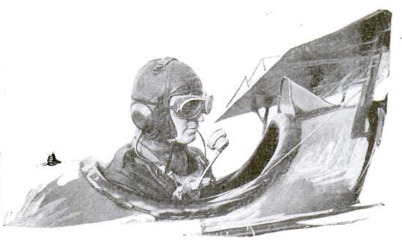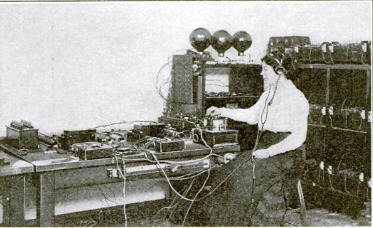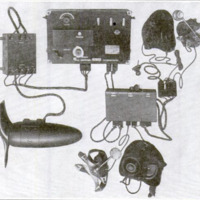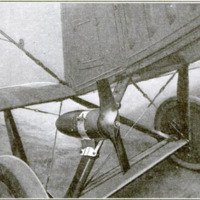-
Titolo
-
The improvements in radio-telephony and its importance for the communication
-
Article Title and/or Image Caption
-
Title: Flying a Mile High, He Hears You Speak
-
Subtitle: How the radio-telephone now links the airman with the earth
-
extracted text
-
WHEN suifutoiog V of deven
‘monoplanes soared into the
view of Colonels Reber and Culver at
the 1910 Belmont Park Aviation Tour-
nament, the same thought, oddly
enough, came into both their minds and
was _expressed by Colonel Culver:
“What a splendid thing it would
be in battle if those eleven planes
could be instantly commanded by
their leading pilot! What could be
done with the control of every
evolution from the air or from the
ground, and with each pilot receiv-
ing instructions from moment to
moment!”
Tt is easy even for civilians to see
what this would mean. Directions
given before the flights began, as
conditions changed with the sud-
denness of war-time needs, could be
changed, and each flier could be
told just what to do in a mass
attack on the enemy. As the two
colonels looked back to the wireless
telegraph work that had already
made it possible for pilots to report
‘observations to ground stations miles
away, they determined that this
ideal ‘of a voice-commanded squad-
ron of airplanes should be realized.
What Has Happened Since
In five years the telegraphic branch
had been developed to a point at
which airplane communication was
demonstrated over one hundred and
forty miles at the flying school near
San Diego. In another year it was
possible to telegraph in both directions
between airplanes in flight, without
serious interference from the noises of
wind and motor exhaust.
Early in 1917 the wireless tele-
phone was used to talk from the air
to the ground, and in October of
that year experimental radiophone
outfits for squadron flying were taken
to France for demonstration by Col-
onel Culver.
A year later Major-General William
L. Kenly and Director John D. Ryan,
in charge of the air program of the
nation, announced that the voice-
commanded squadron was a reality,
and that, since the signing of the
armistice had removed the need of
secrecy, its effectiveness could .be
shown to the public.
Demonstrations in Washington, at
which President Wilson and Secretary
Baker were present, banished the last
doubts as to what had seemed an im-
possible dream only six years before.
At one of these demonstrations the
President, standing on the White
House lawn, gave a command to dive.
Immediately a swift de Haviland,
flying overhead, nosed toward the
earth at increased speed until, at the
words “Flatten out,” it turned into
the horizontal and sped on in a great
Magic of Wire Telephony
In wireline telephony we know
that the vibratory sound-waves of
the voice strike against the dia-
phragm of a transmitter, causing
this diaphragm to vibrate in a
similar way. The mechanical
vibrations compress and release a
capsule of carbon granules fastened
immediately behind the diaphragm,
and the variations in pressure create
variations in the resistance, which
the granules oppose to the flow of
an electric current through them.
The intensity of the constant stream
of current generated by a battery
or dynamo, and passing through the
granules, is thus varied in accord-
ance with the voice vibrations.
This fluctuating current is led along
the line wires from the transmitter
to the distant station, and there is
applied to a telephone receiver.
The receiver contains a diaphragm
which is moved magnetically by the
incoming currents, and which vibrates
at a speed and intensity governed
by the variations in the currents. Since
these current-vibrations are similar
to those of the voice at the transmitter,
the receiver-diaphragm vibrations that
they produce are also similar. Conse-
quently the receiver re-
creates sound-waves similar
to those generated by the
voice at the sendingstation,
andthe listener hears a re.
production of the words as
they are spoken into the
transmitter. Although a
number of simultaneous
operations are involved, the
action is evidently not at
all complicated.
Analogous to Wire
Transmission
For transmitting the
voice by wireless an entirely
analogous set of conditions
exists. The main and
obvious difference is that
there are line-wires to con-
duct the continuous stream
of voice-carrying electric
current from the trans-
mitter to the receiver.
Some other way of con-
veying the voice-controlled
vibrations must therefore
be found; and in radio-
telephony this part of
the communication sys-
tem is based upon the
properties of electromag-
netic waves in the so-called
ether of space. Just as a
candle radiates light-waves
in all directions, so a suit-
able radio-generator will
radiate streams of elec-
tromagnetic waves to dis-
tant receivers in any diree-
tion. Having at hand such
effective carrier-waves to
transport signals from point
to point through the air,
whether on the earth's
surface or above it, all that
remains in order to trans- |
mit speech by wireless is
to devise suitable appara-
tus for the sending and
receiving stations.
The wireless transmitter,
like that of the wire tele-
phone, contains a dia-
phragm and a capsule of
carbon granules. However,
instead of merely varying the intens-
ity of a stream of current passing out
over wires to the receiver, the radio-
transmitter varies the strength of a
continuous stream of electromagnetic
waves, these being radiated into space
in all directions from an aerial wire.
A portion of these waves necessarily
reaches the distant receiver, and there
is caught by a similar aerial wire in
which the waves induce high-frequency
varying currents. These currents are
then led to the receiving apparatus,
by which they are first converted and
magnified, and then applied to a tele-
phone instrument in which they re.
produce the sounds spoken.
Imagine a fleet of airplanes in which
each is equipped with a complete
radio-telephone transmitter and re-
ceiver. The pilot of the commanding
airship can control his squadron in-
stantaneously by his spoken orders;
the group can act in unison for attack
or defence, and movements of enemy
airplanes or forces detected by any
observer can be immediately described
to all the others.
Some of the Difficulties Overcome
The manufacture of a suitable hel-
met that would exclude the terrific
explosions of the 400 - horsepower
Liberty motors (which are
invariably used without
‘mufling-chambers) was only
less difficult than the pro-
duction of a good trans-
miter.
When one considers how
the ordinary telephone picks
up the noises of passing
trolley cars or trucks, it
is easy to appreciate the
amount of work that was
required to make a micro
phone which was marvel-
ously sensitive to the human
voice and yet scarcely af-
fected by the thunder of
the motors or the rushing
of the wind.
Another knotty problem
‘was the arrangement of the
aerial wires so that they
would not trail far behind
the airplane and become
entangled when loops or
dives were performed, or
when the other airplanes
of the flying squadron ap-
proached. This was solved
by the use of short un-
weighted wires dragging
from the wing-tips, rather
than the long single cable
that was first utilized, and
which suspended a lead
weight some three hun-
dred feet below and behind
the airship.
Future A the Radio-
Telephone
It is difficult to foresee
‘the future of airplane radio-
telephony, for its greatest
value is doubtless in cone
nection with group flying.
But the day of the com‘mercial airplane seems
dawning. When
‘groupsof airplanes
travel together
from city to
city, their pas-
sengers willsurely appre-
ciate theradio-
telephone.
-
Autore secondario
-
John Vincent (Article writer)
-
Lingua
-
eng
-
Data di rilascio
-
1919-05
-
pagine
-
54-55
-
Diritti
-
Public domain (Google digitized)
-
Archived by
-
Davide Donà
-
Marco Bortolami (editor)









